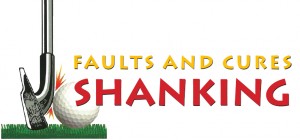Faults and Cures – Shanking
It might be the most offensive word in the lexicon of golf – shank. Some people don’t even want to hear the word, and genuinely get upset if you say it. They come up with other terms such as “lateral,” “hosel rocket,” etc.
Shanking is dreaded by most golfers, because, as the old saying goes, the toughest shot in golf is the one right after you shank. Since people don’t know why they shanked the ball, since in most cases it feels like they made their normal swing, they dread their next iron shot.
All is not lost, though, as the possible reasons for shanking can all be fixed. Yes, there are several reasons why people shank the ball, and it is up to the teacher to figure out which reason is the cause and to come up with an appropriate solution.
Cause: Poor clubhead path.
Solution: Box drill. A clubhead path that comes either from too far outside-in or inside-out can expose the hosel to the ball. The best fix for this is to get a box, such as a golf club box, and place it parallel to the target line just outside of the ball. Leave about ½ inch (1 cm) between the box and the toe of the club at impact. A student who comes into the ball with a poor path will strike the box.
Cause: Elevating the spine through impact.
Solution: Maintain consistent spine angle. Some golfers will get their spine angle more vertical through impact than what it should be, causing the clubhead to move away from their body at impact, thereby risking hosel contact. This might be because the golfer has sore or tight back muscles from practicing too much. If this is the case, it is imperative for the golfer to stretch out the back before the round or practice session. If the golfer’s back is healthy but he or she still raises up, emphasizing staying level by placing the grip end of a club on top of the student’s head can help the teacher get the student to maintain levels.
Cause: Tension.
Solution: Back and forth drill. Tension can cause a student to fail to release properly through impact, leaving the clubface open and exposing the hosel to the ball. This is especially prevalent for pitch shot shanks, and is often accompanied by an awkward dipping of the knees and/or back shoulder. If you diagnose this to be the case, have the student swing their wedge back and forth a few times a few inches inside the ball, and then, on the backwards movement of the club, step into the ball and hit it with the continuous motion. This should return the feeling of reduced tension and a proper release through impact.
Cause: Weight too much towards toes at impact.
Solution: “Hit” ball on toe of club. This is hard for golfers to detect, because to them, it feels like they should be hitting the ball on the sweet spot and instead they’re contacting it on the hosel. Most likely, their weight is too close to their toes at impact. Assuming they are standing the proper distance from the ball, have the student simply feel like they are hitting the ball on the toe of the club instead of trying to hit it on the sweet spot. Chances are this will get their weight distributed properly between the heels and the toes, and it won’t be long before the golfer’s perception of reality and reality match once again. Note – this solution applies only if the golfer is standing the proper distance away from the ball at address. If they are standing too close, then the proper solution is to start with the proper address position and then go from there.
Cause: Shut clubface on takeaway.
Solution: Square clubface on takeaway. Some who shank shut the clubface during the takeaway, and then counter this by opening the face during impact. If the timing is right, a good shot can result, but opening the face too much through impact again exposes the hosel to the ball. A good solution is to have the student put their hands together in front of them horizontally, thumbs up. Have them swing their arms to the right. They can see their thumbs remain up and their palms vertical. Next, have them do this with a golf club. Finally, have them assume a golf posture and have them swing back to toe-up at the 9 o’clock takeaway position.
Shanking is a frustrating problem for golfers to try to fix on their own. The golf teacher can be a valuable asset in correcting the problem and getting the student back on the road to a shank-free existence.





